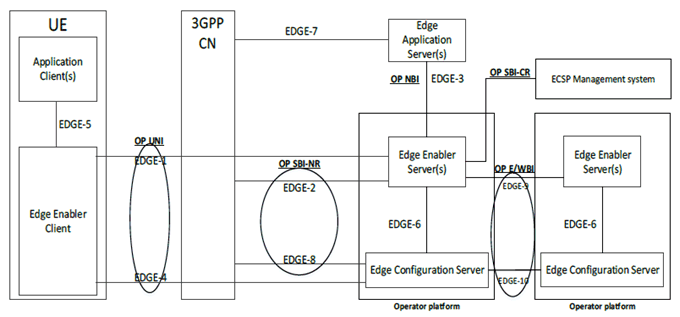Content for TR 23.958 Word version: 18.0.0
6 Alignment of EDGEAPP with GSMA OP
6.1 General
6.2 Relationship between EDGEAPP architecture and GSMA OPG reference architecture
...
...
6 Alignment of EDGEAPP with GSMA OP p. 13
6.1 General p. 13
Clause 6 describes the alignment between 3GPP EDGEAPP and GSMA OP by illustrating the mapping relationship between 3GPP EDGEAPP architecture and GSMA OP architecture (which includes ECS, EES and Edge management system) as described in clause 6.2.
6.2 Relationship between EDGEAPP architecture and GSMA OPG reference architecture p. 13
Figure 6.2-1 illustrates the relationship between EDGEAPP architecture and GSMA OPG reference architecture [3].

Figure 6.2-1: Relationship between EDGEAPP architecture and GSMA OPG reference architecture
(⇒ copy of original 3GPP image)
(⇒ copy of original 3GPP image)
EDGE-1 and EDGE-4 reference points can support similar function(s) as OP's User-Network interface (UNI), providing the Edge Enabler Client (corresponding to Edge/User Client in OP) with the information required to access the edge services. EDGE-1/EDGE-4 neither impact nor overlap with other existing 3GPP interfaces between the UE and the network, catering to the OP's requirements on UNI.
EDGE-2 and EDGE-8 reference points can support similar function(s) as OP's Southbound interface (SBI), through which the edge enabler layer (corresponding to the operator platform) access the 3GPP network capabilities and services (e.g. SCEF/NEF). Specifically, EDGE-2 and EDGE-8 cater to the requirements of the SBI-NetworkResource interface. ECSP management system as specified in TS 28.538 caters to the requirements of OP's SBI-CloudResource interface.
EDGE-3 reference point can support similar function(s) as OP's Northbound interface (NBI), exposing the capabilities of Edge Enabler Server to the Edge Application Servers (EAS) hosted on the edge. OP's NBI also expands capabilities exposure to ASPs, for example to on-board applications to be deployed as EASs based on specific criteria.
EDGE-9 and EDGE-10 reference point can support similar function(s) as OP's East/Westbound interface (E/WBI), allowing the edge enabler layer to interact within and beyond its domains e.g., between operator platforms. OP's E/WBI focuses on use cases like user and application roaming or resource sharing across domains.